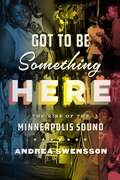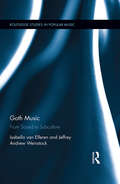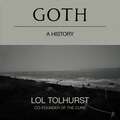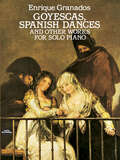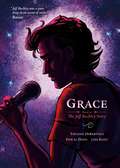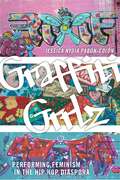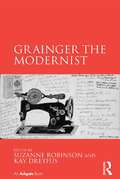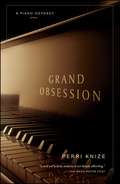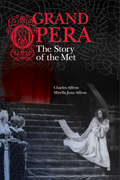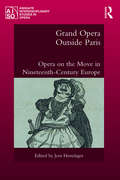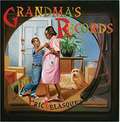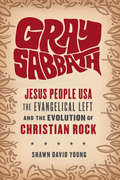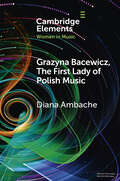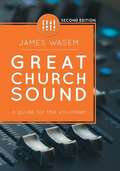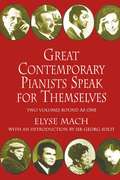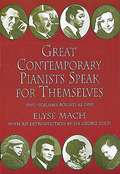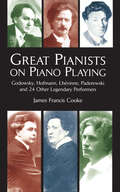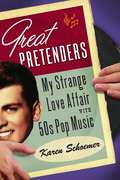- Table View
- List View
Got to Be Something Here: The Rise of the Minneapolis Sound
by Andrea SwenssonBeginning in the year of Prince&’s birth, 1958, with the recording of Minnesota&’s first R&B record by a North Minneapolis band called the Big Ms, Got to Be Something Here traces the rise of that distinctive sound through two generations of political upheaval, rebellion, and artistic passion.Funk and soul become a lens for exploring three decades of Minneapolis and St. Paul history as longtime music journalist Andrea Swensson takes us through the neighborhoods and venues, and the lives and times, that produced the Minneapolis Sound. Visit the Near North neighborhood where soul artist Wee Willie Walker, recording engineer David Hersk, and the Big Ms first put the Minneapolis Sound on record. Across the Mississippi River in the historic Rondo district of St. Paul, the gospel-meets-R&B groups the Exciters and the Amazers take hold of a community that will soon be all but erased by the construction of I-94. From King Solomon&’s Mines to the Flame, from The Way in Near North to the First Avenue stage (then known as Sam&’s) where Prince would make a triumphant hometown return in 1981, Swensson traces the journeys of black artists who were hard-pressed to find venues and outlets for their music, struggling to cross the color line as they honed their sound. And through it all, there&’s the music: blistering, sweltering, relentless funk, soul, and R&B from artists like Maurice McKinnies, Haze, Prophets of Peace, and The Family, who refused to be categorized and whose boundary-shattering approach set the stage for a young Prince Rogers Nelson and his peers Morris Day, André Cymone, Jimmy Jam, and Terry Lewis to launch their careers, and the Minneapolis Sound, into the stratosphere. A visit to Prince&’s Paisley Park and a conversation with the artist provide a rare glimpse into his world and an intimate sense of his relationship to his legacy and the music he and his friends crafted in their youth.
Goth Music: From Sound to Subculture (Routledge Studies in Popular Music)
by Jeffrey Andrew Weinstock Isabella van ElferenIs "goth music" a genre, and if so, how does it relate to the goth subculture? The music played at goth club nights and festivals encompasses a broad range of musical substyles, from gloomy Batcave reverberations to neo-medieval bagpipe drones and from the lush vocals of goth metal to the harsh distortion of goth industrial. Goth Music: From Sound to Subculture argues that within this variegated musical landscape a number of key consistencies exist. Not only do all these goth substyles share a number of musical and textual characteristics, but more importantly these aspects of the music are constitutive of goth social reality. Drawing on their own experiences in the European and American goth scenes, the authors explore the ways in which the sounds of goth inform the scene’s listening practices, its fantasies of other worlds, and its re-enchantment of their own world. Goth music, this book asserts, engenders a musical timespace of its own, a musical chronotope that is driven by nostalgic yearning. Goth Music: From Sound to Subculture reorients goth subcultural studies onto music: goth music must be recognized not only as simultaneously diverse and consistent, but also as the glue that holds together goth scenes from all over the world. It all starts with the music.
Goth: A History
by Lol TolhurstGoth is an entertaining and evocative personal history of Goth music and culture, told by a true insider. Lol Tolhurst explores the godfathers of goth who established the genre's roots - THE CURE, which he co-founded with Robert Smith, contemporaries SIOUXSIE AND THE BANSHEES, BAUHAUS, JOY DIVISION - plus many more great bands that offered a place of refuge for the misfits of the 80s and ever since. Lol offers a fascinating deep dive into the movers and shakers of goth, imbued with his personal memories as well as those of fellow musicians, magicians and artists who make goth such an inevitable and enduring movement. Along the way he examines acts such as DEPECHE MODE and COCTEAU TWINS who helped the darkness expand. Finally, Tolhurst examines the legacy of goth music, and shows how its influence can still be seen to this day across music, film, TV, visual arts and social media. As thoughtful and thorough as it is utterly bewitching, Goth is a timeless testament to why Goth matters - and why it always will.
Goth: A History
by Lol TolhurstFollowing his memoir Cured, a fascinating deep dive into the dark Romanticism of Goth music, a misunderstood genre and culture, by co-founder of The Cure, Lol TolhurstGOTH is an entertaining and engaging historical memoir of the genre of Goth music and culture, exploring creative giants like The Cure, Siouxsie and the Banshees, Bauhaus, Joy Division and many more great bands that offered a place of refuge for the misfits of the 80s and ever since. Written by Lol Tolhurst, co-founder of The Cure, this book offers a fascinating deep dive into the movers and shakers of goth with stories and anecdotes from Tolhurst's personal memories as well as the musicians, magicians and artists who made it all happen - the people, places and events that made goth an inevitable and enduring movement . Starting with the Origins of Goth, Tolhurst explores early art and literature that inspired the genre and looks into the work of T.S Eliot, Edgar Allan Poe, Sylvia Plath, Albert Camus and more. He also outlines the path of Gothic forebears and shows how many musicians played in punk bands before transitioning into goth endeavours. Next, he introduces readers to the 'Architects of Darkness' - Bauhaus, Siouxsie and the Banshees, Joy Division and The Cure - the godfathers of goth who established the genre's roots. Following these early bands, Tolhurst discusses a group he calls the 'Spiritual Alchemists', consisting of bands like Depeche Mode, Cocteau Twins and more, who helped the darkness expand into the culture. He also tracks the expansion of the genre overseas, from England to New York, Los Angeles and beyond. Gothic fashion was an important part of the movement as well and Tolhurst discusses the clothing that accompanied and complemented the music. Finally, Tolhurst examines the legacy of goth music and shows how its influence can still be seen to this day across music, film, TV, visual arts, social media and so much more, finally concluding with 'Why Goth matters!'(P) 2023 Hachette Book Group
Goth: A History
by Lol TolhurstThe co-founder of The Cure and author of Cured delivers a fascinating deep dive into the dark romanticism of Goth music, a misunderstood genre and culture. GOTH is an entertaining and engaging historical memoir, and a journey through Goth music and culture, exploring creative giants like The Cure, Siouxsie and the Banshees, Bauhaus, Joy Division, and many more great bands that offered a place of refuge for the misfits of the &‘80s and ever since. Written by Lol Tolhurst, co-founder of The Cure, this book offers a riveting retrospective of the genre&’s iconic movers and shakers, infused with stories from Tolhurst&’s personal trove of memories, as well as anecdotes about the musicians, magicians, and artists who made it all happen—the people, places, and things that made Goth an inevitable and enduring movement. Starting with the Origins of Goth, Tolhurst explores early art and literature that inspired the genre and looks into the work of T.S Eliot, Edgar Allan Poe, Sylvia Plath, and Albert Camus, among others. He also outlines the path of Gothic Forebears and shows how many musicians played in punk bands before transitioning into Goth endeavors. Next, he introduces readers to the &“Architects of Darkness&”—Bauhaus, Siouxsie and the Banshees, Joy Division, and The Cure—the Godfathers of Goth who established the genre's roots. Following these early bands, Tolhurst discusses a group he calls the &“Spiritual Alchemists,&” consisting of bands like Depeche Mode, Cocteau Twins, and more, who helped the darkness expand into the culture. He also tracks the expansion of the genre overseas, from England to New York, Los Angeles, and beyond. Gothic fashion was an important part of the movement as well, and Tolhurst discusses the clothing that accompanied and complemented the music. Finally, Tolhurst examines the legacy of Goth music, and shows how its influence can still be seen to this day across music, film, TV, visual arts, social media, and more. As thoughtful and thorough as it is utterly bewitching, GOTH is a timeless testament to why Goth matters—and why it always will.
Goyescas, Spanish Dances and Other Works for Solo Piano
by Enrique GranadosThis remarkable book brings together in one sturdy, yet inexpensive volume four of the most memorable and frequently played sets of works for the piano by Enrique Granados (1867-1916), one of Spain's greatest modern composers. They are reprinted here from early editions.The piano suite Goyescas, first performed in Barcelona in 1911, would bring Granados his greatest, most enduring success. In each of its six pieces, the composer employs wild, insistent melody and highly individual rhythm, harmony, and coloring to create dramatic impressions of paintings by Goya, to whose work Granados was deeply drawn.The exquisite Spanish Dances, a suite of early works, were much admired by the leading composers of the day, among them Massenet, Saint-Saëns, and Grieg, not only for their distinctive musical qualities, but also for the new direction in Spanish music which they heralded. They remain today perhaps the most performed of Granados's work.Less well known in America are the beautiful Escenas poéticas and Escenas románticas, two suites which reflect Granados's interest in the music of Grieg, Schumann, and Liszt, yet are filled with the great Spanish composer's original modulations and characteristic melodic writing. Together, the four suites offer performing artists, teachers, students, and music lovers a rich treasury of the finest and most enduring of Granados's compositions for the piano.
Grace: Based on the Jeff Buckley Story
by Tiffanie DeBartoloA moving graphic biography for music lovers, Grace: The Jeff Buckley Story is painstakingly researched and created in collaboration with Jeff Buckley's estate.California, 1991. All his life, people have told Jeff Buckley how much he looks like his father, the famous ’60s folksinger he barely knew. But Jeff believes he has gifts of his own: a rare, octave-spanning voice and a songwriting genius that has only started to show itself. After he falls in love with a mysterious girl in New York, he sets out to make a name for himself outside his father’s shadow. What follows are six turbulent years of music, heartbreak, hope, and daring—culminating in a tragedy that’s still reverberating in the music world today. Written by Tiffanie DeBartolo and with art by Pascal Dizin and Lisa Reist, this graphic novel biography uses archival material provided by Jeff’s mother, Mary Guibert, to reveal the young songwriter in the process of becoming a legend.
Graffiti Grrlz: Performing Feminism in the Hip Hop Diaspora
by Jessica Nydia Pabón-ColónAn inside look at women graffiti artists around the worldSince the dawn of Hip Hop graffiti writing on the streets of Philadelphia and New York City in the late 1960s, writers have anonymously inscribed their tag names on trains, buildings, and bridges. Passersby are left to imagine who the author might be, and, despite the artists’ anonymity, graffiti subculture is seen as a “boys club,” where the presence of the graffiti girl is almost unimaginable. In Graffiti Grrlz, Jessica Nydia Pabón-Colón interrupts this stereotype and introduces us to the world of women graffiti artists.Drawing on the lives of over 100 women in 23 countries, Pabón-Colón argues that graffiti art is an unrecognized but crucial space for the performance of feminism. She demonstrates how it builds communities of artists, reconceptualizes the Hip Hop masculinity of these spaces, and rejects notions of “girl power.” Graffiti Grrlz also unpacks the digital side of Hip Hop graffiti subculture and considers how it widens the presence of the woman graffiti artist and broadens her networks, which leads to the formation of all-girl graffiti crews or the organization of all-girl painting sessions.A rich and engaging look at women artists in a male-dominated subculture, Graffiti Grrlz reconsiders the intersections of feminism, hip hop, and youth performance and establishes graffiti art as a game that anyone can play.
Grainger the Modernist
by Suzanne Robinson Kay DreyfusUnaccountably, Percy Grainger has remained on the margins of both American music history and twentieth-century modernism. This volume reveals the well-known composer of popular gems to be a self-described ’hyper-modernist’ who composed works of uncompromising dissonance, challenged the conventions of folk song collection and adaptation, re-visioned the modern orchestra, experimented with ’ego-less’ composition and designed electronic machines intended to supersede human application. Grainger was far from being a self-sufficient maverick working in isolation. Through contact with innovators such as Ferrucio Busoni, Léon Theremin and Henry Cowell; promotion of the music of modern French and Spanish schools; appreciation of vernacular, jazz and folk musics; as well as with the study and transcription of non-Western music; he contested received ideas and proposed many radical new approaches. By reappraising Grainger’s social and historical connectedness and exploring the variety of aspects of modernity seen in his activities in the British, American and Australian contexts, the authors create a profile of a composer, propagandist and visionary whose modernist aesthetic paralleled that of the most advanced composers of his day, and, in some cases, anticipated their practical experiments.
Grand Obsession
by Perri KnizeA fascinating, lyrical memoir about one woman's obsessive search for the perfect piano-and about finding and pursuing passion at any age How can a particular piano be so seductive that someone would turn her life upside down to answer its call? How does music change human consciousness and transport us to rapture? What makes it beautiful? In this elegantly written and heartfelt account, Perri Knize explores these questions with a music lover's ardor, a poet's inspiration, and a reporter's thirst for knowledge. The daughter of a professional musician, Knize was raised in a home saturated in classical music, but years have passed since she last played the instrument that mesmerized her most: the piano. Surprised by a sudden, belated realization that she is meant to devote her life to the instrument, she finds a teacher and soon decides to buy a piano of her own. What begins as a search for a modestly priced upright leads Knize through dozens of piano stores all over the country, and eventually ends in a New York City showroom where she falls madly in love with the sound of a rare and pricey German grand. "At the touch of the keys, I am swept away by powerful waves of sound," Knize writes. "The middle section is smoky and mysterious, as if rising from the larynx of a great contralto. The treble is bell-like and sparkling, full of color, a shimmering northern lights. A soul seems to reside in the belly of this piano, and it reaches out to touch mine, igniting a spark of desire that quickly catches fire." The seduction is complete. But the piano far exceeds Knize's budget. After a long and painful dalliance, she refinances her house to purchase the instrument that has transfixed her. The dealer ships it to her home in Montana, and she counts the days until its arrival. When at last she sits down to play, almost delirious with anticipation, the magical sound is gone and the tone is dead and dull. Devastated, she calls in one piano technician after another to "fix" it, but no one can. So begins the author's epic quest to restore her piano to its rightful sound, and to understand its elusive power. This journey leads her into an international subculture of piano aficionados -- concert artists, passionate amateurs, dealers, technicians, composers, and builders -- intriguing characters all, whose lives have also been transformed by the spell of a piano. Along the way she plays hundreds of pianos, new and vintage, rare and common, always listening for the bewitching tone she once heard from her own grand, a sound she cannot forget. In New York, she visits the high-strung technician who prepared her piano for the showroom, and learns how a wire tightened just so, or an artfully softened hammer can transform an unremarkable instrument into one that touches listeners to their core. In Germany, she watches the workers who built her piano shape wood, iron, wool, and steel into musical instruments, and learns why each has its own unique voice. In Austria, she hikes the Alps to learn how trees are selected to build pianos, and how they are grown and harvested. With each step of her journey, Knize draws ever-closer to uncovering the reason her piano's sound vanished, how to get it back, and the deeper secret of how music leads us to a direct experience of the nature of reality. Beautifully composed, passionately performed, Grand Obsession is itself a musical masterpiece.
Grand Obsession
by Perri KnizeA fascinating, lyrical memoir about one woman's obsessive search for the perfect piano-and about finding and pursuing passion at any age How can a particular piano be so seductive that someone would turn her life upside down to answer its call? How does music change human consciousness and transport us to rapture? What makes it beautiful? In this elegantly written and heartfelt account, Perri Knize explores these questions with a music lover's ardor, a poet's inspiration, and a reporter's thirst for knowledge. The daughter of a professional musician, Knize was raised in a home saturated in classical music, but years have passed since she last played the instrument that mesmerized her most: the piano. Surprised by a sudden, belated realization that she is meant to devote her life to the instrument, she finds a teacher and soon decides to buy a piano of her own. What begins as a search for a modestly priced upright leads Knize through dozens of piano stores all over the country, and eventually ends in a New York City showroom where she falls madly in love with the sound of a rare and pricey German grand. "At the touch of the keys, I am swept away by powerful waves of sound," Knize writes. "The middle section is smoky and mysterious, as if rising from the larynx of a great contralto. The treble is bell-like and sparkling, full of color, a shimmering northern lights. A soul seems to reside in the belly of this piano, and it reaches out to touch mine, igniting a spark of desire that quickly catches fire." The seduction is complete. But the piano far exceeds Knize's budget. After a long and painful dalliance, she refinances her house to purchase the instrument that has transfixed her. The dealer ships it to her home in Montana, and she counts the days until its arrival. When at last she sits down to play, almost delirious with anticipation, the magical sound is gone and the tone is dead and dull. Devastated, she calls in one piano technician after another to "fix" it, but no one can. So begins the author's epic quest to restore her piano to its rightful sound, and to understand its elusive power. This journey leads her into an international subculture of piano aficionados -- concert artists, passionate amateurs, dealers, technicians, composers, and builders -- intriguing characters all, whose lives have also been transformed by the spell of a piano. Along the way she plays hundreds of pianos, new and vintage, rare and common, always listening for the bewitching tone she once heard from her own grand, a sound she cannot forget. In New York, she visits the high-strung technician who prepared her piano for the showroom, and learns how a wire tightened just so, or an artfully softened hammer can transform an unremarkable instrument into one that touches listeners to their core. In Germany, she watches the workers who built her piano shape wood, iron, wool, and steel into musical instruments, and learns why each has its own unique voice. In Austria, she hikes the Alps to learn how trees are selected to build pianos, and how they are grown and harvested. With each step of her journey, Knize draws ever-closer to uncovering the reason her piano's sound vanished, how to get it back, and the deeper secret of how music leads us to a direct experience of the nature of reality. Beautifully composed, passionately performed, Grand Obsession is itself a musical masterpiece.
Grand Opera
by Charles Affron Mirella Jona AffronThe Metropolitan has stood among the grandest of opera companies since its birth in 1883. Tracing the offstage/onstage workings of this famed New York institution, Charles Affron and Mirella Jona Affron tell how the Met became and remains a powerful actor on the global cultural scene. In this first new history of the company in thirty years, each of the chronologically sequenced chapters surveys a composer or a slice of the repertoire and brings to life dominant personalities and memorable performances of the time. From the opening night Faust to the recent controversial production of Wagner's "Ring," Grand Opera is a remarkable account of management and audience response to the push and pull of tradition and reinvention. Spanning the decades between the Gilded Age and the age of new media, this story of the Met concludes by tipping its hat to the hugely successful "Live in HD" simulcasts and other twenty-first-century innovations. Grand Opera's appeal extends far beyond the large circle of opera enthusiasts. Drawing on unpublished documents from the Metropolitan Opera Archives, reviews, recordings, and much more, this richly detailed book looks at the Met in the broad context of national and international issues and events.
Grand Opera Outside Paris: Opera on the Move in Nineteenth-Century Europe (Ashgate Interdisciplinary Studies in Opera)
by Jens HesselagerNineteenth-century French grand opera was a musical and cultural phenomenon with an important and widespread transnational presence in Europe. Primary attention in the major studies of the genre has so far been on the Parisian context for which the majority of the works were originally written. In contrast, this volume takes account of a larger geographical and historical context, bringing the Europe-wide impact of the genre into focus. The book presents case studies including analyses of grand opera in small-town Germany and Switzerland; grand operas adapted for Scandinavian capitals, a cockney audience in London, and a court audience in Weimar; and Portuguese and Russian grand operas after the French model. Its overarching aim is to reveal how grand operas were used – performed, transformed, enjoyed and criticised, emulated and parodied – and how they became part of musical, cultural and political life in various European settings. The picture that emerges is complex and diversified, yet it also testifies to the interrelated processes of cultural and political change as bourgeois audiences, at varying paces and with local variations, increased their influence, and as discourses on language, nation and nationalism influenced public debates in powerful ways.
Grandfather's Gamelan (Fountas & Pinnell Classroom, Guided Reading Grade 4)
by Maribel Lechuga Jonas WestoverNIMAC-sourced textbook
Grandma's Records
by Eric VelasquezCoretta Scott King and John Steptoe New Talent Award winner Eric Velasquez shines in the perfect picture book to read with grandparents. <p><p> Every summer, Eric goes to live with his grandmother in El Barrio (Spanish Harlem) while his parents work. Through the long hot days, Grandma fills her apartment with the blaring horns and conga drums of Bomba y Plena, salsa, and merengue-the music she grew up with in Puerto Rico-sharing her memories and passions with Eric. <p> But Eric sees Grandma in a new light when she gets them tickets to hear their favorite band in concert. The music sounds so different than it does at home on their scratchy records. And then the lead singer serenades Grandma right in front of the whole audience! <p> Join Eric Velasquez on a magical journey through time and across cultures, as a young boy's passion for music and art is forged by a powerful bond between generations.
Gravando audiolivros: Como gravar a narração de seu audiolivro para Audible, iTunes e muito mais
by George Smolinski Mariana BaroniComo gravar a narração de seu audiolivro para a Audible, o iTunes e muito mais! Venda mais livros e construa sua marca! Áudio está na moda! Não é nenhum segredo que, seja por podcasts ou em audiolivros, as pessoas queiram escutar a conteúdo tanto quanto queiram vê-lo ou lê-lo. Comece a gravar seu próprio audiolivro com este livro! Este é um guia completo com instruções em vídeo que permitirão que você grave seu próprio audiolivro. Eu sei porque usei ESSAS MESMAS TÉCNICAS PARA GRAVAR este mesmo livro para a Audible! Os audiolivros são a maior tendência em publicação hoje. Houve um crescimento explosivo nas vendas de audiolivros nos últimos 4 anos e você precisa transformar seu livro em formato audiolivro hoje. Este guia o ensinará os prós e contras da gravação de audiolivros, mesmo se você quiser gravar sozinho a narração de seu audiolivro. O que este guia discutirá: 1. Qual equipamento você precisará para gravar seus audiolivros e narrações; 2. Como começar a gravar audiolivros com os software GarageBand e Audacity; 3. Dicas e truques que o ajudarão a começar com o pé direito a narração do audiolivro; 4. Como fazer upload de seu livro finalizado para Audible e o iTunes; 5. Recursos úteis para terceirizar a produção de seu audiolivro se você não for do tipo “faça você mesmo”. Entre na onda dos audiolivros e aprenda como gravar os seus hoje mesmo!
Gray Sabbath: Jesus People USA, Evangelical Left, and the Evolution of Christian Rock
by Shawn David YoungShawn David Young is director of music industry and recording technology at York College of Pennsylvania. He has published research on the counterculture of the 1960s, communal living, music festivals, the politics of popular music, and Christian rock music in a number of journals, including VOLUME! The French Journal of Popular Music Studies, Religion Compass, Religions, and the Journal of Religion and Popular Culture.
Gray Sabbath: Jesus People USA, the Evangelical Left, and the Evolution of Christian Rock
by Shawn YoungFormed in 1972, Jesus People USA is an evangelical Christian community that fundamentally transformed the American Christian music industry and the practice of American evangelicalism, which continues to evolve under its influence. In this fascinating ethnographic study, Shawn David Young replays not only the growth and influence of the group over the past three decades but also the left-leaning politics it developed that continue to serve as a catalyst for change.Jesus People USA established a still-thriving Christian commune in downtown Chicago and a ground-breaking music festival that redefined the American Christian rock industry. Rather than join "establishment" evangelicalism and participate in what would become the megachurch movement, this community adopted a modified socialism and embraced forms of activism commonly associated with the New Left. Today the ideological tolerance of Jesus People USA aligns them closer to liberalism than to the religious right, and Young studies the embodiment of this liminality and its challenge to mainstream evangelical belief. He suggests the survival of this group is linked to a growing disenchantment with the separation of public and private, individual and community, and finds echoes of this postmodern faith deep within the evangelical subculture.
Grażyna Bacewicz, The 'First Lady of Polish Music' (Elements in Women in Music)
by Diana AmbacheThis Element explores the life and work of Grażyna Bacewicz (1909-1969), as a composer, violinist, pianist and author. She lived a remarkable life in Poland, navigating the complex world of Polish communist society and Soviet dominance after the Second World War, and brought Polish music to wider European attention. The Element describes the historical context of her life, her major achievements, and the language and development of her compositions, which attracted notable interest in Polish musical life. She wrote a wide range of pieces, making a significant contribution to the string repertoire, with important String Quartets and violin works. In her sixty years she achieved impressive triumphs as a women composer, served the Polish Composers Union and often judged major international competitions.
Great Church Sound: A Guide for the Volunteer
by James WasemThis practical guide is the best place to start for anyone needing to gain a better understanding of the church sound system and how to get a great sounding mix. <p><p> Church sound techs from all backgrounds and experience levels will benefit from the clear explanations, plain instruction, and focus on the fundamentals that matter most. Pastors and Team Leaders will appreciate this easy to follow handbook that delivers a consistent training platform for new tech team members. Whether you want to get rid of feedback, improve your mix, or lead your team effectively, Great Church Sound is the resource for you. There are ever increasing expectations placed on volunteer church sound techs and other technical production team members. That's not a bad thing. The travesty is that many of our willing volunteers are often charged with delivering exceptionally professional results with nary a hint of adequate training or supporting resources (other than perhaps a prayer that "the pastor's mic doesn't squeal again this week"). <p><p> This Second Edition addresses many of the needs expressed by thousands of volunteer church sound techs as they faithfully navigate weekly worship services and special events. Several enhancements and organizational changes have been made in order to make this a more complete training guide, not only for volunteers, but for church leaders desiring to empower their team with the tools for audio excellence.
Great Contemporary Pianists Speak for Themselves (Dover Books On Music: Piano)
by Elyse Mach"Mach has produced a book of uncommon interest." — Washington Post"Mach's interviews will enhance the pleasure of any concertgoer." — PeopleIn this rich collection of fascinating interviews with 25 of the world's greatest pianists of the contemporary era, Elyse Mach has chosen to let the artists speak freely and develop their thoughts about music, their lives, and their careers with a minimum of interruption. The result is a treasury of reminiscences and reflections that are not only remarkably candid and revealing but entertaining and thought-provoking as well. Through the eyes of these inspired musicians, we get an intimate look at the concert scene and the life of the concert pianist, as well as insights into the artists' feelings about their art, their performance anxieties, the music they play, and many other topics. Enhanced with 50 photographs, this book will be welcomed by anyone with an interest in serious music and piano artistry.Pianists interviewed in this volume include Claudio Arrau, Vladimir Ashkenazy, Alfred Brendel, John Browning, Alicia de Larrocha, Misha Dichter, Rudolf Firkušný, Glenn Gould, Vladimir Horowitz, Byron Janis, Lili Kraus, Rosalyn Tureck, André Watts, Paul Badura-Skoda, Jorge Bolet, Youri Egorov, Janina Fialkowsha, Leon Fleischer, Emil Gilels, Stephen Hough, Zoltán Kocsis, Garrick Ohlsson, Cécile Ousset, Murray Perahia, and Ivo Pogorelich."The fascinating world behind the glamour of the concert platform comes alive in very fluid and readable style." — Rosalyn TurecK
Great Contemporary Pianists Speak for Themselves (Volumes 1 and #2)
by Elyse MachVolume 1 pianists are Arrau, Ashkenazy, Brendel, Browning, de Larrocha, Dichter, Firkusny, Gould, Horowitz, Janis, Kraus, Tureck and Watts). Volume 2 pianists are Badura-Skoda, Bolet, Egorov, Fialkowska, Fleisher, Gilels, Hough, Kocsis, Ohlsson, Ousset, Perahia, and Pogorelich.
Great Pianists on Piano Playing: Godowsky, Hofmann, Lhevinne, Paderewski and 24 Other Legendary Performers (Dover Books On Music: Piano)
by James Francis CookeLearning from a virtuoso is something that any piano student would love to do. But while master classes are rare, this remarkable book allows us to share the thoughts, musical insights, and experience of the world's greatest pianists.In 28 separate interviews, these legendary artists talk about piano technique, musical development, what is required to achieve virtuoso piano artistry, and many other topics related to keyboard performance. Included are Busoni's "Important Details in Piano Study," Rachmaninoff's "Essentials of Artistic Playing," Paderewski's "Breadth in Musical Art," Grainger's "Modernism in Pianoforte Study," as well as fascinating perceptions and commentary from Bachaus, Carreño, Gabrilowitsch, Godowsky, Hofmann, Lhévinne, Scharwenka, and other masters.Containing a wealth of information and practical advice, including biographical sketches of each musician, Great Pianists on Piano Playing is a one-of-a-kind collection that piano students, teachers, and any music lover will treasure.
Great Pretenders
by Karen SchoemerFebruary 1964: The Beatles step onto the tarmac at JFK International Airport and turn the country on its head. It's the advent of rock and roll's uninterrupted reign, youthful rebellion, and overt teenage sex. It's also the deathblow for the pop music of another generation -- the songs of Pat Boone and Georgia Gibbs -- and all its perky, white-bread conformity. Not two years later, Karen Schoemer is born, and comes of age with rock and roll. While her parents might enjoy the new music, the cultural upheaval passes them by, and they cling to the promises made by the music they loved as teenagers, the sweet, innocent 1950s pop of Patti Page, Frankie Laine, and the like. But having courted and wed against a backdrop of ideals peddled by this music -- finding true love, living happily ever after -- Schoemer's parents, like so many people, are crushed by disappointment when love doesn't deliver what the songs promised. Fifties pop falls quickly off the charts; their marriage eventually falls apart. In Great Pretenders, a lively, provocative blend of memoir and music criticism, former Newsweek pop music critic Karen Schoemer tries to figure out what went so wrong, way back in the hazy past, for her parents' marriage and for the music of their youth. To find the answers, she embarks on a strange, lonely journey in search of some of the brightest stars of the 1950s. Schoemer's search started when, twenty years after her parents' divorce, the new Connie Francis box set appeared on her desk at Newsweek. Now a successful rock critic dispensing post-punk opinions to the hipoisie, she was about to toss aside this relic when she was struck by the cover image of Francis, which bore an uncanny resemblance to her own mother; on a whim, she played one of the CDs. For all their cloying, simplistic sentimentality, songs like "Where the Boys Are" had an undeniable power -- "the sound of every teenage girl in every bedroom on every lonely Saturday going back a thousand years." It was the music of her parents' long-lost adolescence, and much to her surprise, it moved her. Thus Schoemer, arbiter of Gen X cool, found herself falling into the saccharine thrall of 1950s pop music, that pariah of the rock establishment. Even as her colleagues tried to steer her away from the terminally uncool genre, she tracked down seven former pop idols of the late 1950s and early 1960s: Connie Francis, Fabian, Pat Boone, Patti Page, Tommy Sands, Georgia Gibbs, and Frankie Laine. As she became privy to their inner lives and immersed herself in their music, Schoemer revised her own notions about the fifties at the same time that she explored her family's vexed dynamic. The result is a wonderful romp through an unappreciated chapter in music history and, more important, through her own past. Full of humor, insight, and unflinching honesty, Great Pretenders bucks the received wisdom, explores the intersections of our private lives and pop culture, and broadens our understanding of a crucial moment in our history.
Greek Music in America (American Made Music Series)
by Tina BucuvalasWinner of the 2019 Vasiliki Karagiannaki Prize for the Best Edited Volume in Modern Greek StudiesContributions by Tina Bucuvalas, Anna Caraveli, Aydin Chaloupka, Sotirios (Sam) Chianis, Frank Desby, Stavros K. Frangos, Stathis Gauntlett, Joseph G. Graziosi, Gail Holst-Warhaft, Michael G. Kaloyanides, Panayotis League, Roderick Conway Morris, National Endowment for the Arts/National Heritage Fellows, Nick Pappas, Meletios Pouliopoulos, Anthony Shay, David Soffa, Dick Spottswood, Jim Stoynoff, and Anna Lomax Wood Despite a substantial artistic legacy, there has never been a book devoted to Greek music in America until now. Those seeking to learn about this vibrant and exciting music were forced to seek out individual essays, often published in obscure or ephemeral sources. This volume provides a singular platform for understanding the scope, practice, and development of Greek music in America through essays and profiles written by principal scholars in the field. Greece developed a rich variety of traditional, popular, and art music that diasporic Greeks brought with them to America. In Greek American communities, music was and continues to be an essential component of most social activities. Music links the past to the present, the distant to the near, and bonds the community with an embrace of memories and narrative. From 1896 to 1942, more than a thousand Greek recordings in many genres were made in the United States, and thousands more have appeared since then. These encompass not only Greek traditional music from all regions, but also emerging urban genres, stylistic changes, and new songs of social commentary. Greek Music in America includes essays on all of these topics as well as history and genre, places and venues, the recording business, and profiles of individual musicians. This book is required reading for anyone who cares about Greek music in America, whether scholar, fan, or performer.
